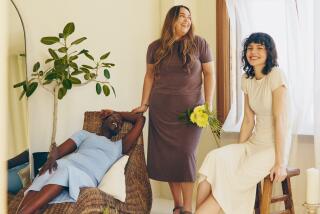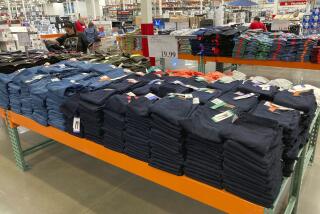Men Just Want to Have Fun, Clothing Companies Say
LAS VEGAS â Bud Konheim began to realize the potential of the male apparel market when his company, womenâs clothing manufacturer Nicole Miller, received a message from fans of one of the few lines Miller produced for men in 1995: colorful, loose-fitting, casual shirts.
âThank you for liberating us from the standard âold-boyâ corporate dress,â said the letter, accompanied by photographs of male executives with some Miller shirts covering their heads.
âMen are having fun with clothes now,â said Konheim, chief executive of the New York-based apparel company, which this fall will offer a wider variety of casual menâs shirts and will introduce a line of casual pants and sports jackets. âThe menswear market is on fire because men are lightening up.â
Nicole Miller is one of many design houses that are either expanding their offerings for men or moving into the male market for the first time. Many of the new players introduced their menâs lines this week at Magic, a big Las Vegas apparel convention that attracts manufacturers and buyers for retail chains.
The reason: The menâs market is now the bright light in an otherwise lackluster industry. Sales of menswear rose 7.3% in 1996, compared with the 5.8% increase for the total apparel market, according to NPD Group, a research firm in Port Washington, N.Y. Consumer demand for casual clothing and sportswear is the source of most of that increase, industry analysts say.
Sales of menswear leaped more than 21% between 1989 and 1996, to $41.2 billion, according to Tactical Retail Solutions, a New York-based market research firm. While the market for womenâs clothes is twice the size of men, sales of womenâs fashions dropped 10% over the same period.
Designers joining in on the menswear boom include Todd Oldham, known for his daring stylings for women. He introduced a menâs line at the convention. Kenneth Cole took the plunge by unveiling a line of suits and sportswear.
Also, prominent womenâs wear designers such as Isaac Mizrahi, Cynthia Rowley and Mark Eisen are launching menâs collections. Jil Sander, Alexander McQueen, Miuccia Prada, Marc Jacobs and Vivienne Westwood are among the high profile designers that had already jumped into menswear in the last two years.
âDesigners are like actors,â said Millerâs Konheim. âThey want the public to appreciate their work. Designers are moving into menswear because thereâs a growing appreciation of their work. We know men are appreciating fashion more because theyâre buying more.â
Economic and cultural changes are behind the menswear trend, said Tom Julian, a New York-based apparel consultant who served as fashion advisor for Magic.
âThereâs a shift in corporate lifestyle because dress codes are breaking down,â Julian said. âMore companies have casual Fridays and some allow casual dress throughout the week. Also, more people are telecommuting--working from home. And, more and more people are starting their own business.â
Male consumers, and women who purchase for men, are also being enticed by the greater array of styles and fabrics such as new and lighter derivatives of nylon, rayon and polyester, as well as blends of wool and silk, Julian said.
âThe real story behind the demand for new fabric is color,â he said. âThereâs iridescent versions of bronze and olive. Seafoam and copper are hot. And so is brown and mustard. These colors are striking, and theyâre boosting sales of casual pants and knitwear.â
Thus, while suit sales declined 6.2% for the 12-month period ended June 30, sales of knit tops rose nearly 7% and sales of casual pants climbed 11% over the same span.
Retailers are responding to the growing demand for casual menâs garb. The number of retailers at Magic, which ended Thursday, rose 33% compared with the Magic convention in February. The convention is organized twice a year by Woodland Hills-based Magic International.
The growing demand for fashion-forward casual clothing is a boon to apparel makers in Southern California, the U.S. center for such manufacturing. Among those popular with young men are companies such as the Irvine-based Mossimo Inc., Laguna Niguel-based Ocean Pacific and Los Angeles-based Karl Kani. Two New York-based firms--Fubu and Phatfarm--and the San Francisco-based Joe Boxer Jeans are also hot, said apparel consultant Sandy Potter of Los Angeles-based Directives West.
Potter said retailers are trying to keep pace with the changes to make smart purchases. But many are also studying trends to update their private-label clothing.
âRetailers want to expand their private-label lines,â said New York-based apparel consultant Alan Millstein. âThey want a bigger piece of the pie.â
Apparel manufacturers with a niche say they are not threatened by the growing ambitions of retailers.
Daniel Weiss, vice president of sales for Joe Boxer, said retailers can probably sell a private-label version of his companyâs $35 black nylon jogging pants for $10 to $15 less. However, the private-label version would not include Boxerâs distinctive reflective white stripe on the sides.
âThe retailers can beat us on price, but they canât beat on us style,â he said.






